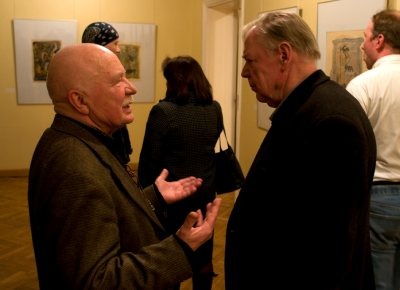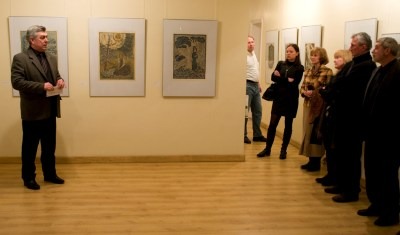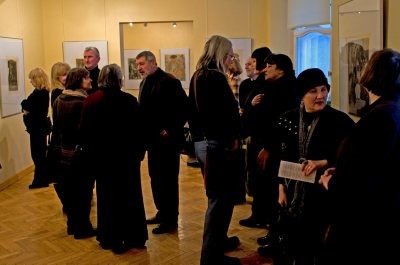SUBTLE CLASSIC – GRAPHIC ARTIST ELENA JAKUTYTĖ 0
Prof. Edmundas Saladžius
www.kamane.lt, 2011 03 11
Elena Jakutytė
E.Jakutytė. "St. George".
E.Jakutytė. "Pied Cuckoo".
Students of E.Jakutytė: graphic artist Petras Repšys and painter Ričardas Povilas Vaitiekūnas.
Moments from the opening of E.Jakutytė's exhibition at A. Žmuidzinavičius Works and Collections Museum.
The graphic artist Elena Jakutytė was born in 1911 in Turkestan, Buchara city. After the death of her father in 1914, she and her mother returned to Lithuania and retreated to Russia after the war broke. She came back to her homeland again after the end of the war. Such are the facts of the artist's biography. After experiencing many hardships, having no chance to continue studies, E.Jakutytė worked in the field not related with art. Finally, after graduating from Kaunas State Institute of Applied and Decorative Art in 1950, where the artist acquired the specialty of graphic art, she obtained the right to teach at Kaunas Secondary Art School.
The silent and concentrated artist had to earn money for living in noisy classrooms. Still, the teacher loved her students and formed their attitude to the world insensibly. Students were proud for her invitations to visit her room in Aukštaičių Street in Kaunas. They used to speak about the West European art, poetry and literature banned at that time.
The works of Elena Jakutytė are understood as the symbol of Lithuanian national identity. Her creation inspired by folk art is close to it by the forms and content. Cycles of prints on themes of folk songs and St. George uphold the national identity which was very important during the period of the Soviet empire. At the same time her works do not lose artistic value and enrich the national tradition by new discovered symbols. Sheets from the cycle “Poet's Garden” testify this.
The works created by the artist in the so-called “defrost” period surprise by the new and unseen interpretation of form, which distances from the direct repetition of works of god carvers frequent in the Lithuanian graphic art. The iconographical St. George gains features of a hardly recognisable anthropomorphic symbol in some works. The form reveals the content stronger and more persuasively.
The cycle on Lithuanian folklore themes may be attributed to the monotype technique. These are hand-painted embossing clichés. The print is the only and cannot be repeated. These graphic works stand out by complicated but integral scale of muted colours. In the opinion of the artist Ričardas Povilas Vaitiekūnas these works surpass the limits of graphic art and reach the persuasiveness of colour painting.
The graphic artist E. Jakutytė has never betrayed her creation and outlook. As a result, the content and form of her creation retain subtlety and purity. The graphic art of E. Jakutytė links the torn tradition of inter-war Lithuanian graphic art and works of artists who emigrated abroad. She encouraged her students to keep the relation with own culture and at the same time to search for the persuasive universal form understandable to other cultures. The creative work of the artist E. Jakutytė may be considered an important stage of history of Lithuanian graphic art.
The retrospective exhibition of works of E.Jakutytė will be open at Kaunas A. Žmuidzinavičius Works and Collections Museum of the National M.K.Čiurlionis Art Museum until the 10th of April.














